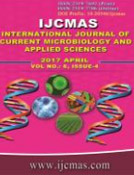


 National Academy of Agricultural Sciences (NAAS)
National Academy of Agricultural Sciences (NAAS)

|
PRINT ISSN : 2319-7692
Online ISSN : 2319-7706 Issues : 12 per year Publisher : Excellent Publishers Email : editorijcmas@gmail.com / submit@ijcmas.com Editor-in-chief: Dr.M.Prakash Index Copernicus ICV 2018: 95.39 NAAS RATING 2020: 5.38 |
Simultaneous increase of (CO2) and temperature causing significant changes in rice crop growth and productivity, but limited studies has been done in past to examine the interactive effect of these two key variables on the incidence of brown spot and sheath blight of rice. Thus, an experiment was conducted at ICAR Research Complex for Eastern Region, Patna, by growing rice genotypes (Rajendra bhagwati, IR83376-B-B-24-2, IR 64 and IR84895-B-127-CRA-5-1-1) inside open top chambers (OTCs) and open field condition with two levels of carbon dioxide (ambient and elevated; 500±25 ppm) and temperature (ambient and ambient+2°C) during kharif season of 2016 in order to determine their simultaneous effect on incidence of brown spot and sheath blight. One hour averages of CO2 in the elevated CO2 OTC ranged between 455 and 510 ppm with a mean of 482 ppm and a standard deviation (S.D.) of 12.7ppm. LAI of the elevated CO2 treatment was significantly (p<0.05) greater than the control OTC and open field at all times in both kharif seasons. Brown spot (Helminthosporium oryzae) and Sheath blight (Rhizoctonia solani) the disease incidence was observed at physiological maturity stage in kharif season during 2016. The effects of disease on yield contributing characters were also observed. The incidence of brown spot ranged from 24.91 to 51.25 % and highly susceptible variety was observed IR-64. The disease incidence of sheath blight of paddy ranged from 34.33 to 47.08 % and highly susceptible variety was observed Rajendra bhagwati. It was observed that disease incidence was gradually increased from flowering stage to maturity stage with the age of the plant and minimum incidence gave the maximum yield.
 |
 |
 |
 |
 |